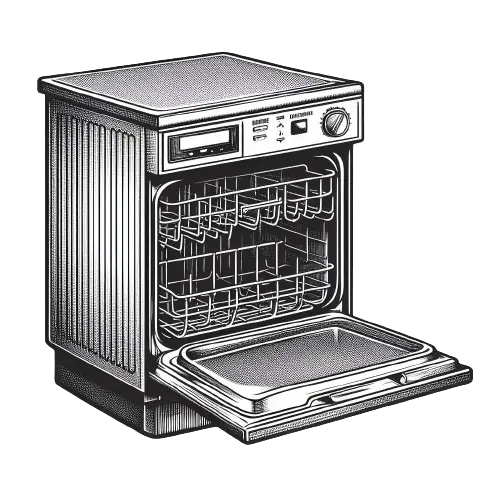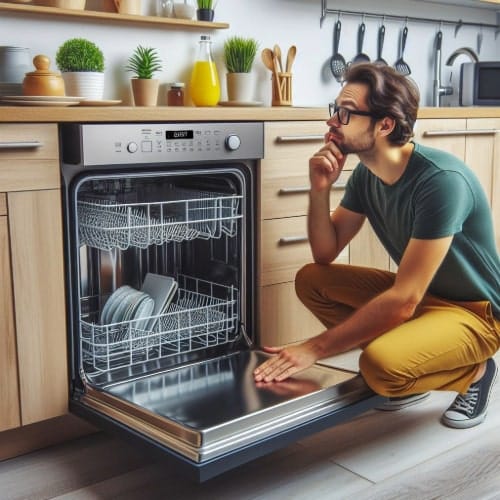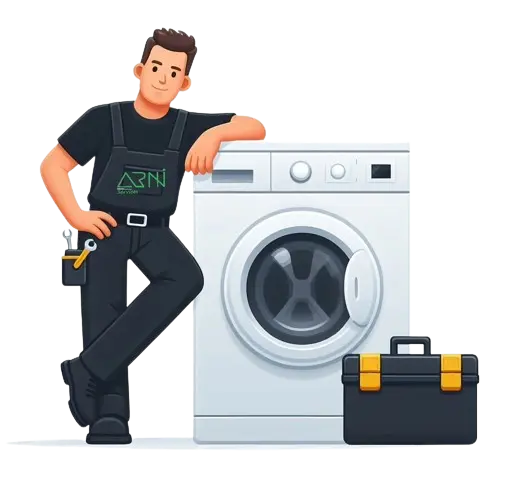Did you see a weird code on your Samsung dishwasher? Just trying to make it go away might not really fix anything, and the code could come back. What to do? First, try to find out why this code is showing up on your dishwasher. It might be telling you something is wrong with it. If it’s hard to figure out, it’s a good idea to talk to someone who knows a lot about dishwashers. They can help you understand the problem and get your dishwasher working right again.


Repairing a dishwasher often involves dealing with electrical components, a task that can be complex and hazardous, especially for those not familiar with appliance repair and electrical safety. If you are unsure about what you are doing or lack the necessary experience, it is strongly recommended to seek professional assistance. A qualified technician can provide an accurate diagnosis and ensure safe repairs, reducing the risk of injury or further damage to the appliance.
The 5E or SE error code on a Samsung dishwasher indicates a drainage problem. This code signifies that the dishwasher is unable to drain water out properly, which can be due to various issues within the drainage system.
The 4E or 1E error code on a Samsung dishwasher indicates a water supply issue. This code suggests that the dishwasher is not receiving an adequate amount of water or that water is not filling the appliance within a specific time frame, typically at the start of a wash cycle.
The LE error code on a Samsung dishwasher signifies a leakage error. This code is triggered when the dishwasher detects water leakage in its base, activating a safety system to prevent water damage by shutting down the machine’s operations.
The OE error code on a Samsung dishwasher indicates a problem with the dishwasher’s ability to drain water properly. This code is typically triggered when the dishwasher detects an issue that prevents water from being efficiently expelled at the end of a cleaning cycle.

The HE error code on a Samsung dishwasher signifies a heating issue, indicating that the dishwasher is having trouble regulating the water temperature during the wash cycle.
The tE error code on a Samsung dishwasher indicates a problem with the thermistor (temperature sensor), suggesting that the dishwasher’s control unit is receiving incorrect information about the water temperature.
Hot Water Supply Too Hot: The initial guidance you mentioned is correct. If the hot water supply to the dishwasher is set above 80°C (176°F), it can trigger this error. This is more likely if your home’s hot water heater is set to a very high temperature.
Faulty Heating Element: If the dishwasher’s heating element is malfunctioning, it could overheat the water during the wash cycle.
Faulty Thermistor: The thermistor (temperature sensor) may be malfunctioning, causing incorrect temperature readings that lead the dishwasher’s control board to think the water is hotter than it actually is.
Wiring or Connection Issues: Problems with the wiring or connections between the heating element, thermistor, and control board can cause incorrect temperature readings or heating issues.
Control Board Malfunction: In some cases, the dishwasher’s control board itself may be faulty, leading to incorrect operation of the heating element or incorrect processing of temperature readings.
Adjust Hot Water Heater: Ensure your home’s hot water supply is not set above 80°C (176°F). Adjusting the water heater to a lower temperature can prevent the dishwasher from receiving water that’s too hot.
Inspect and Replace Heating Element: If the heating element is faulty, it will need to be inspected and possibly replaced. A continuity test with a multimeter can determine if the element has failed.
Replace Thermistor: If the thermistor is providing incorrect readings, replacing it can resolve the issue. This part is typically not expensive and can be a straightforward fix.
Check Wiring and Connections: Inspect all related wiring and connections for signs of damage, wear, or loose connections. Repair or replace any faulty wiring.
Professional Diagnosis for Control Board: If the problem persists and you suspect the control board, it’s best to have a professional technician diagnose and potentially replace the board, as this can be a more complex and costly repair.

The bE error code on a Samsung dishwasher typically signifies a button error. This code suggests that one of the buttons on the control panel is stuck or being pressed continuously, causing the dishwasher to halt operation and display the error as a protective measure.
The dE error code on a Samsung dishwasher typically indicates a door latch problem. This error suggests that the dishwasher’s control system has detected an issue with the door not closing properly or the latch mechanism not engaging correctly, preventing the dishwasher from starting its cycle.
The 1E or IE error code on a Samsung dishwasher indicates a water inlet problem. This error suggests that the dishwasher is experiencing difficulty in filling with water within a specific time frame, potentially due to an issue with the water supply or the dishwasher’s ability to receive water.
The CE error code on a Samsung dishwasher indicates a communication error. This error suggests that there is a problem with the communication between the dishwasher’s control panel and the main control board, or between other electronic components within the unit.

We come to you, view all service location areas
The PE error code on a Samsung dishwasher indicates an issue with the half-load function, specifically pointing to a malfunction related to the half-load (or zone) control mechanism. This could be due to a problem with the dishwasher’s ability to regulate or control water and spray intensity in one part of the dishwasher, assuming it supports differentiated washing zones for smaller loads.
The LC, LC1, or LE error codes on a Samsung dishwasher indicate a leak detected by the dishwasher’s leak sensor. This error is triggered when moisture or water leakage is detected in the base of the dishwasher, engaging the dishwasher’s leak protection system.
For Samsung dishwashers, the LE error code typically indicates a leakage problem. It signifies that the dishwasher’s leakage sensor has detected excess water in the base pan, possibly due to an internal leak, triggering this warning to prevent water damage.
The OC, 0C, or oE error code on a Samsung dishwasher signals an over-level water error. This code is activated when the dishwasher detects that the water level inside the machine is too high, which can pose risks of water spillage or malfunctioning of the appliance.
The HC error code on a Samsung dishwasher typically indicates a heating issue, specifically pointing to a problem where the water temperature is not increasing as expected during a cycle. This can mean that the dishwasher is having trouble heating the water to the required temperature for effective cleaning.
The PC error code on a Samsung dishwasher indicates a problem related to the water level sensing function. It typically means that the dishwasher’s electronic control system has detected an issue with the water level being too high, which could be due to a malfunction in the water level sensor or its associated circuitry.
The AC, 6C, or 6E error code on a Samsung dishwasher typically indicates a water flow issue, specifically pointing to a problem related to the water supply. This code suggests that the dishwasher is experiencing difficulty in getting an adequate amount of water to properly start or complete a wash cycle.
When dealing with any error codes on your dishwasher, safety should always be your top concern. Make sure to unplug the appliance from the power source before you start troubleshooting or doing any maintenance work to avoid the risk of electric shock. It’s important not to try fixing things that need you to take the dishwasher apart or require special know-how if you’re not fully equipped with the right knowledge and tools. Doing regular upkeep, like cleaning out the filters and making sure the drain hose is set up correctly, can help stop problems with draining and can also help your dishwasher last longer.